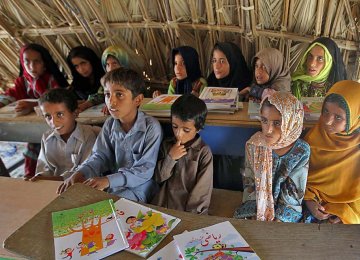Equitable access to schools and learning must be at the heart of the government agenda to unleash the full potential of Iranian youth, particularly those living in deprived areas. Efforts should focus on access, equity and inclusion, quality and learning outcomes, within a continuous learning approach.
On average, educational space per student is more than 5.1 sq meters in the country; however the figure is far below, less than one sq meter, in some disadvantaged regions such as Sistan-Baluchestan, West Azarbaijan, and Hormozgan provinces, the Persian-language government newspaper ‘Iran’ reported.
Abdolaziz Ramesh, CEO of Tehran Charity Schools Office, said the figure for educational space per student was hardly 48 sq cm in Chabahar in Sistan-Baluchestan Province.
As per the latest available data released in 2015 by the Education Ministry, there were over 560,000 classrooms in the country, including more than 310,000 classrooms at the primary level.
Last week, Mohammad Taqi Nazarpour, deputy minister of education and head of the Organization for Development, Renovation, and Equipping Schools, said “12 provinces had lower educational space than the national average.”
Pointing to educational inequity in some provinces, Mojtaba Zeinivand, advisor to the education minister, said working groups have been formed in deprived areas to develop plans to redress the problems.
The groups have been set up in West Azarbaijan, Sistan-Baluchestan, Hormozgan, and Kerman. “Funds required for the plans will be provided by the presidential office and charity organizations.”
Currently, 1,300 mud-made schools have been identified in the country of which 50% are in Sistan-Baluchestan Province. Also, 84,000 classrooms where over two million students study, still use oil heaters during the cold winters.
These are not the only problems that students living in deprived areas have to contend with. Lack of safe transportation to and from school is another important issue in some regions, wherein many students risk their lives to reach schools. Some students in villages have to pass through rugged terrain and at times dangerous roads and rivers to reach school
Even in provinces which have sufficient educational spaces, 30% of school buildings are distressed and in dire need of renovation, while 20% need to be retrofitted.
Patrons’ Contributions
Over 650,000 local philanthropists and 1,000 Iranian benefactors living abroad are contributing to the construction of schools in deprived areas, said Mohammad Reza Hafezi, director of Charity Schools Association of Iran on Saturday.
“Around 37% of all schools in the country have been constructed with contributions from patrons, and currently more than 2.5 million students are studying in schools built by the association,” he said.
There are more than 106,000 schools in the country, according to the latest figures released by the Education Ministry and 14 million students study at the primary, secondary and high school levels.
Education plays a key role in reducing poverty. At the World Education Forum 2015 in Incheon, South Korea, over 1,600 participants from 160 countries, adopted the Incheon Declaration for Education 2030, setting out a new vision for education.
Organized by UNESCO together with UNICEF, the World Bank, UNFPA, UNDP, UN Women and UNHCR, the participants included over 120 ministers, heads and members of delegations, heads of agencies and officials of multilateral and bilateral organizations, and representatives of civil society, the teaching profession, youth and the private sector.
The declaration in part stated that “Our vision is to transform lives through education, recognizing the important role of education as a main driver of development. We commit with a sense of urgency to a single, renewed education agenda that is holistic, ambitious and aspirational, leaving no one behind.”
The United Nations SDG 4 (2030 Agenda) recognizes education as key to achieving full employment and poverty eradication by ensuring inclusive and equitable quality education and promoting lifelong learning opportunities for all.
It seeks to ensure, among other targets by 2030, that all learners acquire the knowledge and skills needed to promote sustainable development, including, among others, through education for sustainable development and sustainable lifestyles, human rights, gender equality, promotion of a culture of peace and non-violence, global citizenship and appreciation of cultural diversity and of culture’s contribution to sustainable development.






Add new comment
Read our comment policy before posting your viewpoints